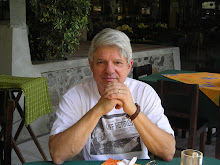On Thursday, March 12, the Johns Hopkins University Bloomberg School of Public Health in Baltimore hosted the world’s first gathering devoted to Peak Oil and Health, with support from the federal Centers for Disease Control and Prevention (CDC) in Atlanta. These are two of the nation’s most prestigious institutions in the fields of public health and health education, and about a hundred people attended in person, with a larger number tuning in to the simultaneous web-cast. The audience was offered a wealth of information about the many ways in which today’s health care services rely on infrastructure and practices that depend upon petroleum. The most likely impacts of Peak Oil on public health were discussed, along with opportunities for public health professionals to prepare for the roles they will play in a post-Peak Oil world.
(CONTINUED HERE)
Blog Comment: The conference provides valuable information. But one conclusion is: "We should begin to devote the remaining oil to ramping up a transfer to renewable energy infrastructures." This is bad advice and misinforms the media, leaders, and the public. The development of renewables uses up precious fossil energy and yields electric power, which is not needed. We need liquid fuels for food production and transportation. When transportation fails the power grid will fail from lack of maintenance (that depends on the highways). Solar and wind gadgets will stand idle as monuments to ignorance. The problems with renewables are documented here.
Tuesday, May 12, 2009
"U.S. Public Health Community Begins to Discuss Peak Oil," By Rob Content, Community Solutions, March/April 2009
Posted by
Clifford J. Wirth, Ph.D., Professor Emeritus, University of New Hampshire
at
Tuesday, May 12, 2009


Labels:
planning,
public health
Subscribe to:
Post Comments (Atom)




3 comments:
Thanks for the feedback, Cliff. My principal intent in reporting on the conference was to capture the state of peak oil awareness within the public health community. I hope that your own clear position on the wasted allocation of resources to renewable energy becomes part of that discussion.
Hi Rob,
Thank you so much for responding.
Peak Oil is a tough sell, as we all know. Peak Oil without alternatives is a harder sell.
Solar and wind energy alternatives represent strong ideological beliefs that stem from years of education by schools and universities. No matter how strong the evidence that there is no basic or applied research supporting a plan for a solar/wind/electric economy, people return to this illusion and false hope. In addition, even if there were so plan, there is an absence of capital and time to implement a trillion dollar makeover of the economy.
It is important that people plan for real Peak Oil impacts and not the impacts they want -- illusions.
In the Peak Oil catastrophe, planning for reality will make the difference in millions of lives lost and how people will survive after the last power blackout.
I hope Community Solutions will play a leadership role in helping people focus on real solutions, not illusions.
In 1980 the National Academy of Sciences focused on this question and gave us the grim news that unless we (1) converted solar/wind power into liquid fuels or energy dense fuels, and (2) developed the breeder reactor we could not make the transition from oil. We have failed on both counts. Source for the NAS study is: http://books.nap.edu/catalog.php?record_id=11771
The NAS study is the most comprehensive energy policy study ever undertaken. Most "scientists" in the energy area have not read this study, and thus they are easily swayed toward illusions about alternatives.
Best regards,
Cliff Wirth
Cliff, bravo for exposing this repetitive blindspot, usually championed by over-zealous environmentalists. Such wishful thinking merely exposes a shortcoming of thermodynamic and EROI basics. In a Post-Peak Oil world such naive platitudes of "saving the world" as opposed to assuming responsibilities within one's immediate region translate into philosophical liabilities.
As reported in the most recent ASPO-USA Review:
The US has become the world's biggest wind-power generator. Of the electricity production added in the country last year, 42 percent came from wind turbines. But as more megawatts come on line, the problem of getting power from wind-swept plains to places where people actually live becomes more urgent. The wind industry group says it needs 19,000 miles of new high-voltage lines — at a cost of about $100 billion — for wind-farm developers to keep building.North American Secessionist Congress, October 2010
Post a Comment